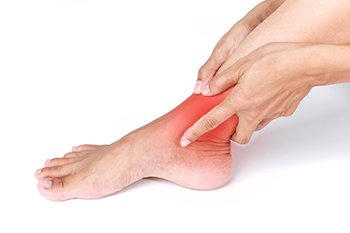Items filtered by date: April 2024
Infected Ingrown Toenails
 Ingrown toenails are among the most common and painful foot issues people face. An ingrown toenail occurs when the edge or corner of the toenail grows into the surrounding skin, causing irritation, redness, swelling, and pain. If left untreated, ingrown toenails can become infected, leading to more severe discomfort and potentially serious complications. Podiatrists, or foot doctors, specialize in treating ingrown toenails and offer effective solutions to alleviate the pain associated with this condition. When you visit a podiatrist for an infected ingrown toenail, they will first assess the severity of the problem. Targeted treatment typically involves gently trimming or removing the ingrown portion of the nail, along with providing relief for any associated infection. Podiatrists can also offer guidance on proper nail care techniques to help prevent future occurrences. If you're dealing with the discomfort of an ingrown toenail, it is suggested that you schedule an appointment with a podiatrist.
Ingrown toenails are among the most common and painful foot issues people face. An ingrown toenail occurs when the edge or corner of the toenail grows into the surrounding skin, causing irritation, redness, swelling, and pain. If left untreated, ingrown toenails can become infected, leading to more severe discomfort and potentially serious complications. Podiatrists, or foot doctors, specialize in treating ingrown toenails and offer effective solutions to alleviate the pain associated with this condition. When you visit a podiatrist for an infected ingrown toenail, they will first assess the severity of the problem. Targeted treatment typically involves gently trimming or removing the ingrown portion of the nail, along with providing relief for any associated infection. Podiatrists can also offer guidance on proper nail care techniques to help prevent future occurrences. If you're dealing with the discomfort of an ingrown toenail, it is suggested that you schedule an appointment with a podiatrist.
Ingrown toenails can become painful if they are not treated properly. For more information about ingrown toenails, contact one of our podiatrists of Itasca Foot & Ankle. Our doctors can provide the care you need to keep you pain-free and on your feet.
Ingrown Toenails
Ingrown toenails occur when a toenail grows sideways into the bed of the nail, causing pain, swelling, and possibly infection.
Causes
- Bacterial infections
- Improper nail cutting such as cutting it too short or not straight across
- Trauma to the toe, such as stubbing, which causes the nail to grow back irregularly
- Ill-fitting shoes that bunch the toes too close together
- Genetic predisposition
Prevention
Because ingrown toenails are not something found outside of shoe-wearing cultures, going barefoot as often as possible will decrease the likeliness of developing ingrown toenails. Wearing proper fitting shoes and using proper cutting techniques will also help decrease your risk of developing ingrown toenails.
Treatment
Ingrown toenails are a very treatable foot condition. In minor cases, soaking the affected area in salt or antibacterial soaps will not only help with the ingrown nail itself, but also help prevent any infections from occurring. In more severe cases, surgery is an option. In either case, speaking to your podiatrist about this condition will help you get a better understanding of specific treatment options that are right for you.
If you have any questions please feel free to contact our offices located in Itasca and Hoffman Estates, IL . We offer the newest diagnostic and treatment technologies for all your foot and ankle needs.
Reminder: When Was the Last Time...?
Foot and Ankle Stress Fractures

Stress fractures are common injuries to the bones of the legs and feet, resulting from repetitive stress rather than sudden injury. These hairline cracks in the bone affect athletes, including runners, basketball players, or dancers. Pain from stress fractures is particularly felt during weight-bearing activities and direct pressure on the bone. They may be difficult to diagnose as the pain often subsides when activity stops. Because they do not always show up on an X-ray, further diagnostic tests, like CT or MRI scans may be needed. Left untreated, stress fractures in the feet or ankles can worsen, leading to more severe complications. Seeking timely medical attention from a podiatrist is essential for proper diagnosis and treatment tailored to individual needs. This facilitates pain relief, promotes healing, and prevents further damage. If you are experiencing symptoms suggestive of a stress fracture, it is suggested that you schedule an appointment with a podiatrist.
Activities where too much pressure is put on the feet can cause stress fractures. To learn more, contact one of our podiatrists from Itasca Foot & Ankle. Our doctors can provide the care you need to keep your pain free and on your feet.
Dealing with Stress Fractures of the Foot and Ankle
Stress fractures occur in the foot and ankle when muscles in these areas weaken from too much or too little use. The feet and ankles then lose support when walking or running from the impact of the ground. Since there is no protection, the bones receive the full impact of each step. Stress on the feet can cause cracks to form in the bones, thus creating stress fractures.
What Are Stress Fractures?
Stress fractures occur frequently in individuals whose daily activities cause great impact on the feet and ankles. Stress factors are most common among:
- Runners
- People affected with Osteoporosis
- Tennis or basketball players
- Gymnasts
- High impact workouts
Symptoms
Pain from the fractures occur in the area of the fractures and can be constant or intermittent. It will often cause sharp or dull pain with swelling and tenderness. Engaging in any kind of activity which involves high impact will aggravate pain.
If you have any questions please feel free to contact our offices located in Itasca and Hoffman Estates, IL . We offer the newest diagnostic and treatment technologies for all your foot and ankle needs.
Choosing Shoes for Arthritic Feet
 Choosing the right shoes is important for people with arthritic feet. Wearing proper footwear can significantly alleviate pain and improve mobility, while the wrong shoes can worsen symptoms of arthritis. Shoes with a wide toe box, cushioned soles, and adequate arch support can help distribute weight evenly, reduce pressure on sensitive areas, and support the foot's natural shape. Additionally, shoes with adjustable closures, such as Velcro straps or laces, can accommodate changes in foot size due to swelling. Podiatrists play a key role in this selection process by evaluating your specific foot structure, identifying areas of concern, and recommending footwear that addresses your unique needs. Podiatrists may also suggest custom orthotics, which are personalized insoles that fit inside your shoe. If you suffer from arthritic feet, it is suggested that you consult a podiatrist when choosing shoes for maximum support and comfort.
Choosing the right shoes is important for people with arthritic feet. Wearing proper footwear can significantly alleviate pain and improve mobility, while the wrong shoes can worsen symptoms of arthritis. Shoes with a wide toe box, cushioned soles, and adequate arch support can help distribute weight evenly, reduce pressure on sensitive areas, and support the foot's natural shape. Additionally, shoes with adjustable closures, such as Velcro straps or laces, can accommodate changes in foot size due to swelling. Podiatrists play a key role in this selection process by evaluating your specific foot structure, identifying areas of concern, and recommending footwear that addresses your unique needs. Podiatrists may also suggest custom orthotics, which are personalized insoles that fit inside your shoe. If you suffer from arthritic feet, it is suggested that you consult a podiatrist when choosing shoes for maximum support and comfort.
Arthritis can be a difficult condition to live with. If you are seeking treatment, contact one of our podiatrists from Itasca Foot & Ankle. Our doctors can provide the care you need to keep you pain-free and on your feet.
Arthritic Foot Care
Arthritis is a joint disorder that involves the inflammation of different joints in your body, such as those in your feet. Arthritis is often caused by a degenerative joint disease and causes mild to severe pain in all affected areas. In addition to this, swelling and stiffness in the affected joints can also be a common symptom of arthritis.
In many cases, wearing ill-fitting shoes can worsen the effects and pain of arthritis. Wearing shoes that have a lower heel and extra room can help your feet feel more comfortable. In cases of rheumatoid arthritis, the arch in your foot may become problematic. Buying shoes with proper arch support that contour to your feet can help immensely.
Alleviating Arthritic Pain
- Exercises that stretch the foot can prevent further pain and injury and increase mobility
- Most of the pain can be alleviated with anti-inflammatory drugs, heat, and topical medications
- Massages can help temporarily alleviate pain.
It is best to see your doctor for the treatment that is right for your needs and symptoms. Conditions vary, and a podiatrist can help you determine the right method of care for your feet.
If you have any questions, please feel free to contact our offices located in Itasca and Hoffman Estates, IL . We offer the newest diagnostic tools and technology to treat your foot and ankle needs.
Causes of Swollen and Painful Ankles
 Swollen and painful ankles can be caused by conditions that range from minor injuries to systemic health conditions. Ankle sprains, which occur when the ligaments that support the ankle are stretched or torn, are among the most common reasons for these symptoms. Sprains typically result from twisting or rolling the ankle awkwardly. Another prevalent cause of swelling is arthritis, which leads to inflammation of the joints, including those in the ankle. Conditions such as gout, where crystals accumulate in the joints, can also target the ankles and lead to intense pain and inflammation. Furthermore, venous insufficiency, a condition in which the veins struggle to send blood from the legs back to the heart, can cause swelling because of excess fluid. Systemic diseases like heart failure, kidney disease, and liver problems can result in ankle swelling due to fluid retention. Identifying the root cause of swollen and painful ankles is important for determining the appropriate treatment strategy, and this is something a foot doctor, or podiatrist, can do. If you have painful or swollen ankles, it is suggested that you promptly schedule an appointment with a podiatrist for diagnosis and treatment.
Swollen and painful ankles can be caused by conditions that range from minor injuries to systemic health conditions. Ankle sprains, which occur when the ligaments that support the ankle are stretched or torn, are among the most common reasons for these symptoms. Sprains typically result from twisting or rolling the ankle awkwardly. Another prevalent cause of swelling is arthritis, which leads to inflammation of the joints, including those in the ankle. Conditions such as gout, where crystals accumulate in the joints, can also target the ankles and lead to intense pain and inflammation. Furthermore, venous insufficiency, a condition in which the veins struggle to send blood from the legs back to the heart, can cause swelling because of excess fluid. Systemic diseases like heart failure, kidney disease, and liver problems can result in ankle swelling due to fluid retention. Identifying the root cause of swollen and painful ankles is important for determining the appropriate treatment strategy, and this is something a foot doctor, or podiatrist, can do. If you have painful or swollen ankles, it is suggested that you promptly schedule an appointment with a podiatrist for diagnosis and treatment.
Ankle pain can have many different causes and the pain may potentially be serious. If you have ankle pain, consult with one of our podiatrists from Itasca Foot & Ankle. Our doctors will assess your condition and provide you with quality foot and ankle treatment.
Ankle pain is any condition that causes pain in the ankle. Due to the fact that the ankle consists of tendons, muscles, bones, and ligaments, ankle pain can come from a number of different conditions.
Causes
The most common causes of ankle pain include:
- Types of arthritis (rheumatoid, osteoarthritis, and gout)
- Ankle sprains
- Broken ankles
- Achilles tendinitis
- Achilles tendon rupture
- Stress fractures
- Tarsal tunnel syndrome
- Plantar fasciitis
Symptoms
Symptoms of ankle injury vary based upon the condition. Pain may include general pain and discomfort, swelling, aching, redness, bruising, burning or stabbing sensations, and/or loss of sensation.
Diagnosis
Due to the wide variety of potential causes of ankle pain, podiatrists will utilize a number of different methods to properly diagnose ankle pain. This can include asking for personal and family medical histories and of any recent injuries. Further diagnosis may include sensation tests, a physical examination, and potentially x-rays or other imaging tests.
Treatment
Just as the range of causes varies widely, so do treatments. Some more common treatments are rest, ice packs, keeping pressure off the foot, orthotics and braces, medication for inflammation and pain, and surgery.
If you have any questions, please feel free to contact our offices located in Itasca and Hoffman Estates, IL . We offer the newest diagnostic and treatment technologies for all your foot care needs.
